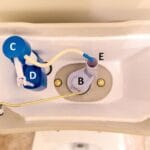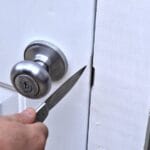Have you ever found yourself standing in your bathroom, listening to the constant trickle of water from your toilet? That sound is not only annoying but also a sign of a problem that could be costing you money on your water bill.
You’re not alone in this, and you might be wondering why your toilet won’t stop running. It’s a common issue that can stem from a variety of causes, each with its own solution. Imagine the peace of mind and savings you could gain by fixing this persistent problem.
Understanding the reasons behind your toilet’s incessant running will empower you to tackle the issue head-on. Whether it’s a worn-out flapper or a misaligned float, knowing what to look for can help you restore tranquility to your bathroom. Dive into the full article to discover practical solutions that will save you time, money, and stress.
Common Causes Of A Running Toilet
A running toilet can be more than just a nuisance; it can lead to increased water bills and potential water damage. Understanding the common causes can help you fix the problem quickly. Let’s dive into the most frequent culprits of this issue.
Faulty Flapper
The flapper is a rubber piece that seals water in the tank until you flush. If it’s damaged or worn out, it won’t seal properly, causing water to leak continuously. This is often the number one suspect in running toilets.
Check if the flapper is closing properly. If not, you might need to replace it. Replacing a flapper is a simple task that you can handle in minutes, saving you from unnecessary water waste.
Float Issues
The float controls the water level in your toilet tank. If it’s set too high, water will spill into the overflow tube, making your toilet run. Adjusting the float can solve this problem.
Try lifting the float arm to see if that stops the water. If it does, adjust the screw on the fill valve to lower the water level. This small tweak can make a big difference in your water usage.
Refill Tube Problems
The refill tube is a thin, flexible tube that refills the bowl after a flush. If it’s positioned incorrectly, it can cause the toilet to run. Ensure the tube is above the water line and inserted into the overflow pipe.
A quick repositioning can resolve this issue. Don’t let a simple tube be the reason for your skyrocketing water bill.
Overflow Pipe Concerns
The overflow pipe prevents the toilet tank from overfilling. If the water level is too high, it will spill into this pipe, causing the toilet to run. This can be a sign of an improperly adjusted float or a faulty fill valve.
Observe the water level in your tank. If it’s touching the top of the overflow pipe, adjust the float or replace the fill valve. Addressing this can ensure your toilet operates smoothly and efficiently.
Have you ever dealt with a running toilet? What was the culprit in your case? Share your experiences and tips in the comments below!
Identifying The Problem
A running toilet can waste water and increase bills. Common causes include a faulty flapper or float. Identifying these issues early helps in fixing them quickly and saving water.
When your toilet won’t stop running, it can be as annoying as a dripping faucet. The sound of continuous water flow is not just a nuisance; it can also lead to higher water bills. Before you call a plumber, it’s essential to understand what’s causing the problem. By identifying the issue yourself, you can save both time and money. Let’s dive into the steps you can take to diagnose your running toilet.Listening For Continuous Water Flow
First, take a moment to listen carefully. Does your toilet make a constant hissing or trickling sound? If so, it might indicate a problem with water continually escaping from the tank. Try this: Close the bathroom door and listen closely. The continuous sound of water might be your first clue that something isn’t right. Sometimes, simply jiggling the handle can stop the noise temporarily. But if it doesn’t, there’s more to investigate.Inspecting The Tank Components
Lift the lid off your toilet tank and take a look inside. The inner workings of a toilet might seem complex, but they’re relatively straightforward. Check the flapper, fill valve, and flush valve for obvious signs of wear or damage. The flapper, for example, should sit snugly over the flush valve. If it’s worn out or misaligned, water can seep into the bowl continuously. You might notice mineral deposits or a warped shape that prevents a tight seal. A simple replacement could solve the issue.Checking Water Levels
Next, examine the water level in the tank. Ideally, the water should be about an inch below the top of the overflow tube. If it’s too high, water may spill into the tube, causing a constant run. Adjust the float mechanism to change the water level. For a ball float, gently bend the arm downward to lower the water level. With a newer cylinder float, turn the adjustment screw to achieve the desired level. Does the water level return to normal, or is it stubbornly high? If adjustments don’t work, the fill valve might need replacing. Addressing these issues promptly can prevent wastage and keep your toilet running smoothly. By taking these steps, you can often solve the problem without professional help. Have you ever fixed a running toilet yourself? Share your experience in the comments below and help fellow readers tackle this common household issue.Quick Fixes For A Running Toilet
A running toilet can be a real nuisance. It wastes water and increases bills. Fortunately, there are quick fixes to tackle this common issue. These fixes are simple and require basic tools. You don’t need to be a plumbing expert. Read on to discover how you can stop your toilet from running.
Replacing The Flapper
The flapper is a rubber piece in the tank. It controls water flow. Over time, it can wear out. If it doesn’t seal well, the toilet keeps running. Replace it with a new one. Turn off the water supply first. Drain the tank by flushing. Remove the old flapper. Install the new one by hooking it in place. Make sure it seals tightly.
Adjusting The Float
The float controls the water level in the tank. If it’s set too high, water overflows into the tube. This causes the toilet to run. Adjust the float by turning the screw on top. Lower the float to reduce water level. Test by flushing. Ensure the water stops at the right level.
Securing The Refill Tube
The refill tube adds water to the bowl after flushing. If it’s too long, water keeps running. Trim the tube if necessary. Make sure it sits above the overflow pipe. This prevents excess water from flowing continuously. Secure the tube with a clip if needed.
Cleaning The Overflow Pipe
Debris can build up in the overflow pipe. This restricts water flow and causes running. Clean the pipe with a brush or cloth. Ensure it’s clear and unobstructed. Check for any blockages. Remove any dirt or grime. A clean pipe ensures proper water flow.

Credit: www.reddit.com
Preventative Maintenance Tips
A running toilet can waste water and increase bills. Check the flapper for wear and tear. Ensure the float is properly adjusted to stop the constant flow. Regularly inspect and replace faulty parts to maintain efficiency.
Toilet issues can be frustrating. A running toilet wastes water and money. Regular maintenance can prevent these problems. Simple, routine checks keep your toilet in top shape. Learn how to maintain your toilet effectively with these tips.Regular Inspection
Inspect your toilet every few months. Look for leaks or worn parts. Check the flapper, fill valve, and chain. Listen for unusual sounds. Catching problems early saves money and water. This keeps your toilet efficient.Using Quality Parts
Quality parts last longer. Invest in trusted brands for your toilet. Cheap parts may break quickly. They can cause more issues over time. Reliable parts ensure fewer repairs. Your toilet stays in good working order.Avoiding Toilet Tank Additives
Tank additives may harm your toilet. They can corrode parts and cause leaks. Use only approved cleaners. Clean your toilet regularly with a brush. Avoid harsh chemicals. This helps extend the life of your toilet.When To Call A Professional
Persistent toilet running signals a hidden issue, needing expert attention. A professional plumber can identify and fix the problem. Ignoring it might lead to higher water bills and further damage.
When your toilet won’t stop running, it can be more than just an annoying sound. It might seem like a minor issue, but it can lead to significant water wastage and higher bills. While some problems are easy to fix on your own, others need a professional touch. Knowing when to pick up the phone and call an expert can save you time, money, and headaches.Persistent Issues
If you’ve jiggled the handle and adjusted the float but the toilet still runs, it might be time for a professional. Consistent running could indicate a deeper issue like a leaky flapper or a faulty fill valve. Think about the frustration of temporary fixes that don’t last—why not get it sorted once and for all?Major Repairs Needed
Have you opened the tank and felt overwhelmed by the complexity? If the toilet’s internal components seem beyond your DIY skills, don’t hesitate to seek help. Major repairs, such as replacing the entire flush system, are best left to those with the right tools and expertise.Water Bill Concerns
A running toilet can significantly increase your water bill. If you’ve noticed a spike and can’t pinpoint the cause, a professional can help diagnose and fix the problem. Why let your hard-earned money go down the drain when a quick call can solve it? Ultimately, deciding when to call a professional is about recognizing when your efforts aren’t enough. Trust the experts to handle the complicated stuff so you can focus on the things that matter most. Have you ever faced a plumbing issue that seemed small but turned into a big deal? Share your story and help others learn from your experience!
Credit: www.youtube.com

Credit: atkinsoninspection.com
Frequently Asked Questions
Why Is My Toilet Always Running?
A worn-out flapper is often the cause. It fails to seal properly. Check it.
How Do I Fix A Running Toilet?
Replace the flapper or adjust the float. These are common solutions. Easy to do.
Can A Running Toilet Increase My Water Bill?
Yes, significantly. It wastes gallons of water daily. Fix it promptly.
Is It Bad To Ignore A Running Toilet?
Yes, it can cause water waste and higher bills. It may lead to bigger issues.
What Tools Do I Need To Fix A Running Toilet?
A screwdriver and pliers usually suffice. You might need a new flapper or float.
Conclusion
Fixing a running toilet saves water and money. Check the flapper first. It often causes leaks and needs replacement. Adjust the float if the tank overfills. This prevents water wastage. Inspect the fill valve for proper function. A faulty valve can lead to constant running.
Regular maintenance helps avoid bigger issues. If problems persist, consider calling a plumber. A professional can provide a lasting solution. Remember, a well-functioning toilet is essential. Keep your bathroom efficient and trouble-free. Simple checks and fixes make a big difference.
Stay proactive and enjoy peace of mind.





